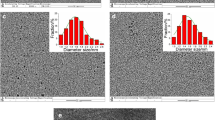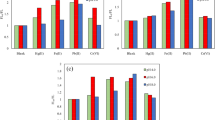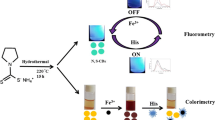Abstract
New portable hydrogel sensors for Al3+ and Fe3+ detection were designed based on the aggregation-induced emission (AIE) and color change of N-doped carbon dots (N-CDs). N-CDs with yellow fluorescence were prepared by a one-pot hydrothermal method from 2,5-dihydroxyterephthalic acid and acrylamide. The fluorescence of N-CDs was enhanced by Al3+ about 20 times and quenched by Fe3+. It was interesting that although Fe3+ showed obvious quenching on the fluorescence of N-CDs it did not cause a noticeable change in the fluorescence of N-CDs + Al3+. The colorless solution of N-CDs appeared blue in the presence of Fe3+ without the influence of Al3+. Therefore, the turn-on fluorometry and colorimetry systems based on N-CDs were constructed for the simultaneous detection of Al3+ and Fe3+. Furthermore, the portable sensing of Al3+ and Fe3+ was realized with the assistance of hydrogel, filter paper, cellulose acetate, and cellulose nitrate film. The proposed approach was successfully applied to the detection of Al3+ and Fe3+ in food samples and cell imaging.
Graphical Abstract








Similar content being viewed by others
References
Ding RY, Cheong YH, Ahamed A, Lisak G (2021) Heavy metals detection with paper-based electrochemical sensors. Anal Chem 93(4):1880–1888
Ma JL, Shen LX, Jiang Y, Ma HT, Lv FJ, Liu JS, Su Y, Zhu N (2022) Wearable self-powered smart sensors for portable nutrition monitoring. Anal Chem 94(4):2333–2340
Rao HB, Liu W, He KQ, Zhao S, Lu ZW, Zhang SX, Sun MM, Zou P, Wang XX, Zhao QB, Wang YY, Liu T (2020) Smartphone-based fluorescence detection of Al3+ and H2O based on the use of dual-emission biomass carbon dots. ACS Sustain Chem Eng 8(23):8857–8867
Bandodkar AJ, Jeerapan I, Wang J (2016) Wearable chemical sensors: present challenges and future prospects. ACS Sensors 1(5):464–482
Lieberzeit PA, Dickert FL (2007) Sensor technology and its application in environmental analysis. Anal Bioanal Chem 387(1):237–247
Dincer C, Bruch R, Costa-Rama E, Fernandez-Abedul MT, Merkoci A, Manz A, Urban GA, Guder F (2019) Disposable sensors in diagnostics, food, and environmental monitoring. Adv Mater 31(30):e1806739
Wang XD, Wolfbeis OS (2020) Fiber-optic chemical sensors and biosensors (2015–2019). Anal Chem 92(1):397–430
Yokel RA, Hicks CL, Florence RL (2008) Aluminum bioavailability from basic sodium aluminum phosphate, an approved food additive emulsifying agent, incorporated in cheese. Food Chem Toxicol 46(6):2261–2266
Greger JL, Sutherland JE (1997) Aluminum exposure and metabolism. Crit Rev Cl Lab Sci 35(4):439–474
Nayak A, Sorci M, Krueger S, Belfort G (2009) A universal pathway for amyloid nucleus and precursor formation for insulin. Proteins 74(3):556–565
Good PF, Olanow CW, Perl DP (1992) Neuromelanin-containing neurons of the substantia nigra accumulate iron and aluminum in Parkinson’s disease: a LAMMA study. Brain Res 593(2):343–346
David CI, Bhuvanesh N, Jayaraj H, Thamilselvan A, Devi DP, Abiram A, Prabhu J, Nandhakumar R (2020) Experimental and theoretical studies on a simple S-S-bridged dimeric Schiff base: selective chromo-fluorogenic chemosensor for nanomolar detection of Fe2+ & Al3+ ions and its varied applications. ACS Omega 5(6):3055–3072
Tripathi KM, Tran TS, Kim YJ, Kim T (2017) Green fluorescent onion-like carbon nanoparticles from flaxseed oil for visible light induced photocatalytic applications and label-free detection of Al(III) ions. ACS Sustain Chem Eng 5(5):3982–3992
Liu P, Li WY, Guo S, Xu DR, Wang MN, Shi JB, Cai ZX, Tong B, Dong YP (2018) Application of a novel “turn-on” fluorescent material to the detection of aluminum ion in blood serum. ACS Appl Mater Interfaces 10(28):23667–23673
Mohandoss S, Ganesan S, Palanisamy S, You S, Velsankar K, Sudhahar S, Lo HM, Lee YR (2023) Nitrogen, sulfur, and phosphorus Co-doped carbon dots-based ratiometric chemosensor for highly selective sequential detection of Al3+ and Fe3+ ions in logic gate, cell imaging, and real sample analysis. Chemosphere 313:137444
Behi M, Gholami L, Naficy S, Palomba S, Dehghani F (2022) Carbon dots: a novel platform for biomedical applications. Nanoscale Adv 4(2):353–376
Omar NAS, Fen YW, Irmawati R, Hashim HS, Ramdzan NSM, Fauzi NIM (2022) A review on carbon dots: synthesis, characterization and its application in optical sensor for environmental monitoring. Nanomaterials 12(14):2365
Yang DW, Guo ZZ, Wang J, Jin YK, Mei Q, Miao P (2019) Carbon nanodot–based fluorescent method for virus DNA analysis with isothermal strand displacement amplification. Part Part Syst Char 36(10):1900273
Feng T, Ai XZ, An GH, Yang PP, Zhao YL (2021) Charge-convertible carbon dots for imaging-guided drug delivery with enhanced in vivo cancer therapeutic efficiency. ACS Nano 10(4):4410–4420
Wang WX, Chen J, Wang DK, Shen YM, Yang LK, Zhang T, Ge J (2021) Facile synthesis of biomass waste-derived fluorescent N, S, P co-doped carbon dots for detection of Fe3+ ions in solutions and living cells. Anal Methods 13(6):789–795
Hu C, Yu C, Li M, Wang X, Dong Q, Wang G, Qiu J (2015) Nitrogen-doped carbon dots decorated on graphene: a novel all-carbon hybrid electrocatalyst for enhanced oxygen reduction reaction. Chem Commun 51(16):3419–3422
Mondal TK, Saha SK (2019) Facile approach to synthesize nitrogen- and oxygen-rich carbon quantum dots for pH sensor, fluorescent indicator, and invisible ink applications. ACS Sustain Chem Eng 7(24):19669–19678
Li PJ, Li SFY (2020) Recent advances in fluorescence probes based on carbon dots for sensing and speciation of heavy metals. Nanophotonics 10(2):877–908
Fan X, Zhang S, Li R, Chen Y, Jiang S, Liu T, Shao X, Wang S, Yue Q (2023) Cotton swabs decorated with Ag@BPQD for the fluorescence determination of 3-aminosalicylic and 5-aminosalicylic acid. Microchim Acta 190(3):82
Ozbek N, Akman S (2016) Method development for the determination of calcium, copper, magnesium, manganese, iron, potassium, phosphorus and zinc in different types of breads by microwave induced plasma-atomic emission spectrometry. Food Chem 200:245–248
Athinarayanan J, Periasamy VS, Alatiah KA et al (2020) Synthesis and cytocompatibility analysis of carbon nanodots derived from palmyra palm leaf for multicolor imaging applications. Sustain Chem Pharm 18:100334
Li R, Zhao P, Qin XQ, Li H, Qu KG, Jiang D-E (2020) First-principles study of heterostructures of MXene and nitrogen-doped graphene as anode materials for Li-ion batteries. Surf Interfaces 21:100788
Li Y, Niu QF, Wei T, Li TD (2019) Novel thiophene-based colorimetric and fluorescent turn-on sensor for highly sensitive and selective simultaneous detection of Al3+ and Zn2+ in water and food samples and its application in bioimaging. Anal Chim Acta 1049:196–212
Yadav R, Rai A, Sonkar AK, Rai V, Gupta SC, Mishra L (2019) A viscochromic, mechanochromic, and unsymmetrical azine for selective detection of Al3+ and Cu2+ ions and its mitotracking studies. New J Chem 43(18):7109–7119
Yang J, Jin X, Cheng Z, Zhou H, Gao L, Jiang D, Jie X, Ma Y, Chen W (2021) Facile and green synthesis of bifunctional carbon dots for detection of Cu2+ and ClO– in aqueous solution. ACS Sustain Chem Eng 9(39):13206–13214
Jia J, Lu W, Cui S, Dong C, Shuang S (2021) Preparation of yellow-emitting carbon dots and their bifunctional detection of tetracyclines and Al3+ in food and living cells. Microchim Acta 188(12):418
Jose Manuel RM, Enrique C, Maricela D, David D, Hugo AN, Hugo T, Gabriel AN, Oscar EC, Mercedes TOG, Jose MRH (2020) Modifying nitrogen species of nitrogen-doped carbon nanotubes by thermal annealing to explore their role in the triiodide reduction reaction. Carbon 167:209–218
Daniel I, Angela G, Michele M, Silvia M, Alejandro C, Lucia N, Manuela B, Claudio T, FrancescoV MP, Paolo F (2018) N-doped graphitized carbon nanohorns as a forefront electrocatalyst in highly selective O2 reduction to H2O2. Chem 4:106–123
Guo DH, Shibuya R, Akiba C, Saji S, Kondo T, Nakamura J (2016) Active sites of nitrogen-doped carbon materials for oxygen reduction reaction clarified using model catalysts. Science 351:361–365
Wen XY, Fan ZF (2016) Linear Schiff-base fluorescence probe with aggregation-induced emission characteristics for Al3+ detection and its application in live cell imaging. Anal Chim Acta 945:75–84
Shi LH, Wang QL, Zhang CH, Zhang GM, Zhang Y, Dong C, Shuang SM (2021) Tricolor emission carbon dots for label-free ratiometric fluorescent and colorimetric recognition of Al3+ and pyrophosphate ion and cellular imaging. Sensor Actuat B 345:130375
Yan L, Zhang BX, Zong ZW, Zhou W, Shuang SM, Shi LH (2023) Artificial intelligence-integrated smartphone-based handheld detection of fluoride ion by Al3+-triggered aggregation-induced red-emssion enhanced carbon dots. J Colloid Interface Sci 651:59–67
Amiri M, Haji Shabani AM, Dadfarnia S, Shokoufi N, Hajipour-Verdom B, Sadjadi S (2020) Carbon dots doped by nitrogen and sulfur for dual-mode colorimetric and fluorometric determination of Fe3+ and histidine and intracellular imaging of Fe3+ in living cells. Microchim Acta 187:562
Thomas NJIE, Raji , Jae-Jin S, Senthilkumar K, Byeong-Cheol A, Yong RL (2016) Turn-off fluorescence sensor for the detection of ferric ion in water using green synthesized N-doped carbon dots and its bio-imaging. J Photochem Photobiol B 158:235–242
Funding
This work was supported financially by the Natural Science Foundation (ZR2022MB052) and the Graduate Education Quality Improvement Plan of Shandong Province (SDYJG21198), and the research foundation of Liaocheng University (318050022 and 318012116).
Author information
Authors and Affiliations
Corresponding author
Ethics declarations
Competing interests
The authors declare no competing interests.
Additional information
Publisher's note
Springer Nature remains neutral with regard to jurisdictional claims in published maps and institutional affiliations.
Supplementary Information
Below is the link to the electronic supplementary material.
Rights and permissions
Springer Nature or its licensor (e.g. a society or other partner) holds exclusive rights to this article under a publishing agreement with the author(s) or other rightsholder(s); author self-archiving of the accepted manuscript version of this article is solely governed by the terms of such publishing agreement and applicable law.
About this article
Cite this article
Yang, D., Shao, T., Wang, X. et al. N-doped carbon dots for the determination of Al3+ and Fe3+ using aggregation-induced emission. Microchim Acta 191, 78 (2024). https://doi.org/10.1007/s00604-023-06143-w
Received:
Accepted:
Published:
DOI: https://doi.org/10.1007/s00604-023-06143-w




